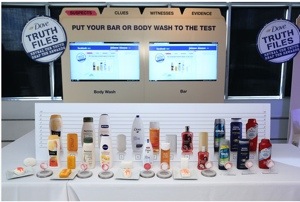Don’t believe everything you read (Part 1)
Women’s Health magazine posted this little tidbit of “information” on page 50 of their July/August issue, and it has generated a lot of comments in the handcrafted soap industry.
Lets break it down, shall we?
“Bar soaps are more drying than liquid because the chemical sodium hydroxide is required to create the cleansing system.”
This is a quote from a chemist, who should definitely know better. Leaving aside for the moment the idea that bar soaps are drying, liquid soaps are made using the synthetic chemical potassium hydroxide. Both sodium hydroxide and potassium hydroxide are commonly known as lye. Bar soaps are not more drying than liquids.
“The upside is that most of today’s bars contain synthetic detergents (they’re easier to manipulate than natural ones which can be unpredictable), making them more skin-softening than they used to be.”
Today’s commercial bars contain synthetic detergents (syndets) because they are cheaper, resulting in higher profits for the manufacturer, and because they produce massive amounts of lather and less residue, not because they are easier to manipulate, or better for your skin! You can read more about synthetic detergents in my earlier post, What is Natural, Part 1.
As far as their “skin-softening” abilities, the only way that you can actually generate softer skin is by eating healthy foods, drinking lots of water, exercising, and using a sunscreen daily. There is no beauty bar, soap, lotion, cream or expensive serum that can give you softer skin. Soap is designed to cleanse your skin by removing dirt and dead cells, which may make your skin look softer. Lotions and creams make your skin feel softer, but the results are temporary, which is why you have to keep reapplying.
A carefully crafted and cured bar of handmade soap is usually “superfatted” which means that the soapmaker has included more oils in the soap than is required to fully neutralize all of the lye, leaving no active lye in the soap. These extra oils are then available to leave a light occlusive barrier on your skin to shield it from the elements. This also helps your skin to look and feel softer. Also, real soap does not strip your skin of its own natural oils. Synthetic detergents are also known as degreasers, and are designed to clean very well.
Some syndets will advertise that they have added moisturizing cream or glycerine, which supposedly gives you softer skin. If you look at the ingredients you will not find any exotic ingredients…..moisturizing creams are made by emulsifying oils and waters, the same oils that are already in handmade soaps. Syndet bars need to add them.
Real handmade soap does not need to add glycerine. Glycerine is a by product of the chemical reaction that makes soap (saponification), and we leave the glycerine where it belongs, in our soap. Commercial manufacturers remove the glycerine and sell it separately to manufacturers of glycerine soaps, thereby increasing their profits.
While we’re on the subject, lets take a look at the Dove Truth Files campaign that was seen everywhere last year, and which claimed that Dove was gentler than other products. They placed cute little pink paper dolls on a Dove bar, and on their competitors, a variety of synthetic bars, liquid cleansers and body washes. In their commercial, the paper on their bar remained intact, while the others disintegrated, supposedly proving how harsh the other products were. The website http://www.dovetruthfiles.com, and the Facebook page http://www.facebook.com/dovetruthfiles are no longer active, but according to what I’ve read, they did not try this comparison with handmade soap, only with other syndets. Here is a picture from one of their PR events, and not a single bar of handmade soap in sight. What a surprise.
Okay, back to business…
“Look for formulas that contain hydrating oils, such as sunflower seed oil and olive oil. Try Kiss My Face Olive Oil Bar Soaps.”
Now this is where I get really steamed! They start off their comments by saying to avoid bar soaps because they contain sodium hydroxide, then finish by recommending that you go ahead and buy a particular brand of bar soap, leaving the impression that this bar soap is better because it does not contain lye! WRONG!
Kiss My Face, like every other bar or liquid soap out there, is made with lye.
Bottom line is this. Consumers need to be aware that every manufacturer, whether they are a large commercial operation or a small handcrafted soapmaker, is ultimately trying to get you to open up your wallet and buy something, and many of them will go to outrageous lengths to do so. Every magazine is trying to fill their pages with content to make you buy the issue. You must educate yourself. Just because you read something on the Internet or in a major magazine, it doesn’t make it true. Don’t believe something just because its a major company giving you the information, or because its featured in a multi-million dollar advertising campaign.
Also, keep in mind that any fool can write a blog. Don’t believe everything you read. Many bloggers will simply regurgitate something they read on someone else’s blog, without doing any independent research. This is how misinformation gets distributed so thoroughly that eventually people start believing that it is definitive and proven.
Be skeptical. Ask questions.
(Unfortunately, Women’s Health is not the only one guilty of repeating misinformation. Two other websites that drive me crazy are Skin Deep, a database administered by the Environmental Working Group, and Livestrong. However, this post is already long enough, and your brain is probably full, so I will take a look at these organizations tomorrow in Part 2.)






Recent Comments